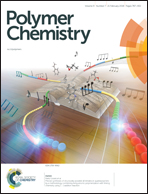A pH-responsive polymer based on dynamic imine bonds as a drug delivery material with pseudo target release behavior†
Abstract
In this study, pentaerythritol tetra(3-mercaptopropionate)-allylurea-poly(ethylene glycol) (PETMP-AU-PEG), produced by the Schiff-base reaction between terminal-aldehyded PEG and PETMP-AU, was used to prepare doxorubicin (DOX)-loaded polymers for triggered release. The DOX-loaded PETMP-AU-PEG polymers had sizes of about 200 nm, non-toxicity and highly pH-sensitive properties. An in vitro release study confirmed that the polymer could release DOX rapidly by cleavage of acid-labile imine bonds of the polymer. The release of DOX at neutral pH was very slow. However, in a weakly acidic environment (pH 6.8 and pH 6.0), it released much faster within the first 2 h. Fluorescence microscopy further verified that DOX released from PETMP-AU-PEG polymers could be pH sensitive. According to the results of cytotoxicity determination and microscopy imaging of U2OS cells (human osteosarcoma, tumor cells) and MC3T3-E1 Subclone 14 cells (normal tissue cells), the DOX-loaded polymers could maintain high stability in the neutral environment while they release DOX rapidly in response to the very weakly acidic environment. Moreover, it is more important that the U2OS could be inactivated in the micro-acidic environment produced by its own growth, even in a neutral environment, without any chemical reagent addition.



 Please wait while we load your content...
Please wait while we load your content...